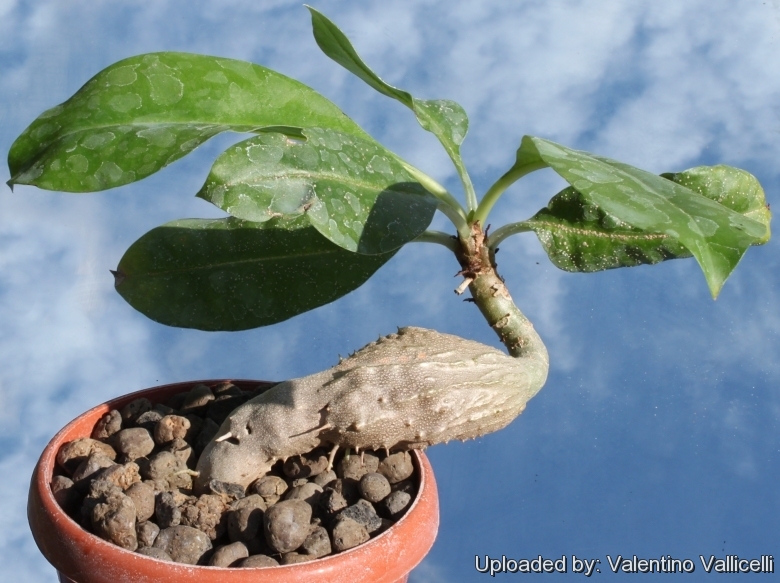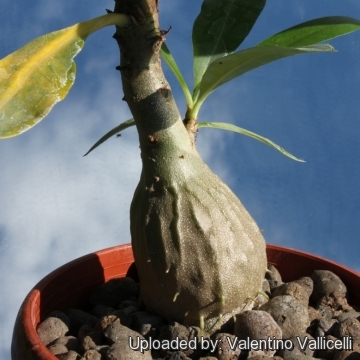Accepted Scientific Name: Myrmecodia tuberosa Jack
Trans. Linn. Soc. London 14: 123 1823

Myrmecodia armata Photo by: Valentino Vallicelli
Origin and Habitat: Southern Asia
Habitat: They arecommon epiphytes on savanna-forest trees often in montanious areas and grow free from the ground attached to the stems of other plants from which they obtain no food
Synonyms:
See all synonyms of Myrmecodia tuberosa
back
Accepted name in llifle Database:Myrmecodia tuberosa JackTrans. Linn. Soc. London 14: 123 1823Synonymy: 26
back
Common Names include:
ENGLISH: Ant Plant
INDONESIAN (Bahasa Indonesia): Sarang Semut, Sarang semut tanaman
JAVANESE (Basa Jawa): Omah semut
KOMI (Коми ): Мирмекодия
MARI (Кырык Мары / олык марий ): Мирмекоди
SPANISH (Español): Hormiga plantas
UDMURT (Удмурт): Мирмекодия
Description: It is a remarkable smallish shrub-like, epiphytic, semi-succulent plant usually less than 25 cm tall, with a tuberous stem which is permeated by passages and cavities which serve as nests for an immense numbers of stinging-ants. The tuber clings to trees with its roots, shelter the ants and serve as a reservoir of food. This is referred to as the 'ant plant'
Stem: The base of the stem develops a large swollen, corky, semi-succulent, caudex (tuber-like lower part) about 10 cm thick often growing hanging downward. The tuber is rounded to ovoid often flattened with ridges and mounds, rough and covered with rows of spines. Spines simple or branched. The interior of the tuber consists of a labyrinth of intercommunicating galleries, often with entrance holes visible in arcs on the upper surface of the tuber, inhabited by ants that defend the plants against parasite insect attack. Ant colonies also provide nutrients to the plants by leaving wastes within the tunnels inside the caudex. Special glands lining the tunnels then absorb nutriment for the plant. This symbiosis allows the plants to effectively gather nutrients (via the ants) from a much larger area than the roots ever could cover. Stems 1 to few usually unmbranched 5-10 cm long.
Roots: The roots show a range of shapes. Some roots may be relatively thick and tough, others very fine and fibrous.
Leaves: Opposite, crowded at the stems apexes, coriaceous, semi-succulent, oblong-cuneated, midrib prominent below. Petiole glabrous, petiolar stipulas ciliated.
Flowers: Sessile, small white; limb of calyx tubular with quite entire borders, corolla funnel-shaped, 4 cleft, throat of corolla closed with arched scales; stamen 4, inclosed; ovarium closed by a fleshy disk, style 1, stigma quadrifid.
Fruit: Drupe-baccate, crowned with the anular base of the calix and containing 4 seeds.
Seed: Papery arillate pyrenae.
Note: The germinating seedlings have a tumid base.
Subspecies, varieties, forms and cultivars of plants belonging to the Myrmecodia tuberosa group
 Myrmecodia armata Photo by: Valentino Vallicelli
Myrmecodia armata Photo by: Valentino VallicelliSend a photo of this plant.The gallery now contains thousands of pictures, however it is possible to do even more. We are, of course, seeking photos of species not yet shown in the gallery but not only that, we are also looking for better pictures than those already present.
Read More... Cultivation and Propagation: Rarely cultivated by amateur growers these plants can be tricky to grow well and are quick to shed their leaves if they are allowed to dry out or become too cold. They needs warm temperatures all year round with high humidity and bright light, though some protection from mid-day sun may be warranted. It is possible to grow them in a mix of peat and perlite, but an open orchids substrate (sphagnum moss, chopped fir bark, and perlite) seems the best combination. The plants are watered when the mix is just barely moist. If humidity is high, plants can be mounted on cork bark plaques for a more natural appearence. Mounted plants will, of course, require more frequent watering. The roots of Hydnophytum and Myrmecodia are very brittle, so great care must be taken when repotting
however, the plants seem capable of producing new roots from any part of the tuber that is in contact with a moist substrate.
Pest and disease: Ant-plants are susceptible to scale and mealybugs.
Propagation: They are very very easy to grow from seed. The flowers are self-pollinating and produce easily fruits and seeds, but the seeds remains viable for a very short time and must be sown immediately after harvesting. The seeds germinate equally well in light and darkness, lay them on the surface of the sowing mix, do not bury them. Fresh seed germinates quickly within a week and often the day after they were sown, ie, within twenty-four hours, and the initial swelling of the tuber is visible almost immediately. Seedlings grow rapidly if kept constantly moist. They can also be reproduced by cuttings, stems will root and grow but do not produce a tuber.











